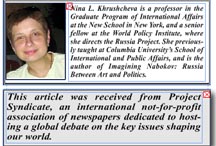By Nina L. Khrushcheva
MOSCOW – From Russia with love? Not in Vladimir Putin’s Russia. In recent days, Putin decided to reaffirm the Russian-Syrian geopolitical marriage of convenience by following through on a sale of deadly arms to Bashar al-Assad’s regime, enabling Assad’s army to slay his opponents with greater precision and resolve. Putin then decided to disavow his own marriage to Lyudmila Shkrebneva, his wife of 29 years, announcing the divorce in as publicly humiliating a way as possible – his wife was standing by his side – for a reserved Russian woman.
For years, rumors had persisted about the failed state of Putin’s marriage. His alleged mistresses were named and proclaimed; one, it is said, sits in the Duma (parliament) as a member of Putin’s tame political party United Russia. But, until now, it was taboo to discuss Putin’s private life publically. A few newspaper editors, indeed, have been known to lose their jobs for publishing even the slightest hints about Putin’s family life.
Vladimir and Lyudmila have rarely been seen together over the past decade, so there was plenty of gossip in Moscow and Saint Petersburg. A few years ago, social media stoked rumors that Putin was in fact already divorced and had remarried the gymnast Alina Kabaeva, who had given birth to his son. (He has two grown daughters, twins, with Lyudmila.)
So the appearance of the couple together at a ballet in the Kremlin was a unique event, and Putin milked it for all it was worth. A journalist, probably in connivance with Putin, had the temerity to ask him about the state of his marriage. He said it was over, with his stone-faced wife on hand to confirm with a silence that spoke louder than words.

One suggestion is that Putin is seeking to divert attention from his support for Syria’s government and from increased repression of his domestic opponents (as the leading economist Sergei Guriev’s recent flight from Russia, following police harassment, demonstrated anew). With a woman who, unlike Lyudmila, will be regularly seen at his side in the future, Putin will present a gentler image at home and abroad.
If Russians – particularly provincial Russian women – believe that a new First Lady will provide some humanizing, empathetic influence on the hard man of the Kremlin, they may be more inclined to give him the benefit of the doubt. This could prove important as he initiates yet another bogus show trial – this time of the anti-corruption activist Aleksei Navalny, now accused of embezzlement. But whether a new woman will help to soften foreigners’ perception of Putin’s cynical diplomacy and increasingly brutal rule is open to question.
Or, it is said, perhaps Putin plans to use next year’s Winter Olympics in Sochi as a grandiose setting for a marriage proposal – and perhaps a wedding – to whoever comes next, possibly Kabaeva.
Another suggestion is that Putin, like many Russians, is partial to all things French. He wants to show that, like France’s most famous politicians, he is a worldly dragueur who can “pull” beautiful women. If former French President Nicolas Sarkozy could divorce and remarry a world-famous model and singer while in office, a Russian president can, too. And Putin has already taken beauty tips from another leading West European Lothario, former Italian Prime Minister Silvio Berlusconi, with Putin’s 2010 facelift making his visage as smooth as that of the frequently Botoxed Berlusconi.
Yet, Italian machismo, with its polished shoes and shiny suits, is different from the more rough-hewn Russian version. And no amount of European male panache can mask Putin’s inner brute.
Indeed, one indication of the openness of a political system is whether or not a leader appears at public functions with his or her spouse. It is a demonstration of modernity and equality that even the secretive Chinese and North Korean leadership appear to have learned of late. The “first lady” institution is a sign that democracies see power as something to be shared, as, say, Bill Clinton or Barack Obama do. Dictators like Hitler, Stalin, and Kim Il-sung, as iron men of destiny, must stand alone.
When the Bolsheviks replaced Russia’s oppressive monarchy with communism in 1917, Vladimir Lenin’s “dictatorship of the proletariat” still left room for the leader not only to have a wife, but to let her have a public role. Nadezhda Krupskaya, the first Soviet First Lady, performed a suffragist function. By contrast, the suicide in 1939 of Stalin’s wife, Nadezhda Allilueva, underscored the reign of terror in the country. Nikita Khrushchev’s 1950’s thaw allowed for his wife, Nina, to accompany him on trips abroad, presenting a homey image of communism with a human face.
But, with Khrushchev’s fall, Soviet first ladies returned to the dacha. Leonid Brezhnev concealed his wife, Viktoria, from public view throughout the 1970s, and Yuri Andropov’s wife, Tatyana Filipovna, was scarcely known until his funeral in 1984.
As with everything else in Russia, change in women’s status came with the onset of Mikhail Gorbachev’s perestroika. Gorbachev’s wife, Raisa, stunned the nation not only by appearing in public, but by being fashionable and expressing opinions of her own. Boris Yeltsin’s accession to power in independent Russia saw only a partial reversal, with his peasant-gowned wife, Naina, making public appearances at his side every now and then.
Just as Putin has created a “managed” democracy, Russians can now look forward to a “managed” Kremlin marriage – one that will attempt to flatter and sweeten their kitschy authoritarian leader in his dotage.





